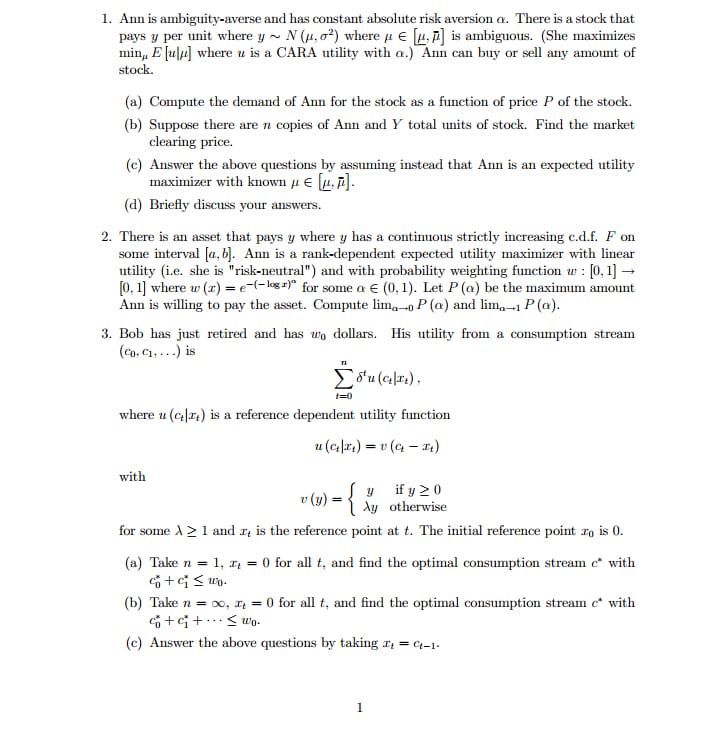
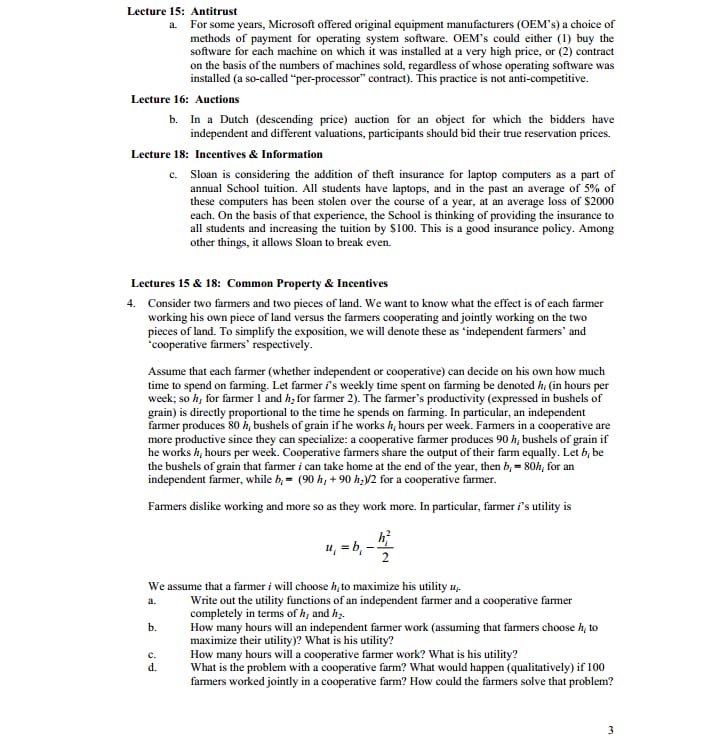
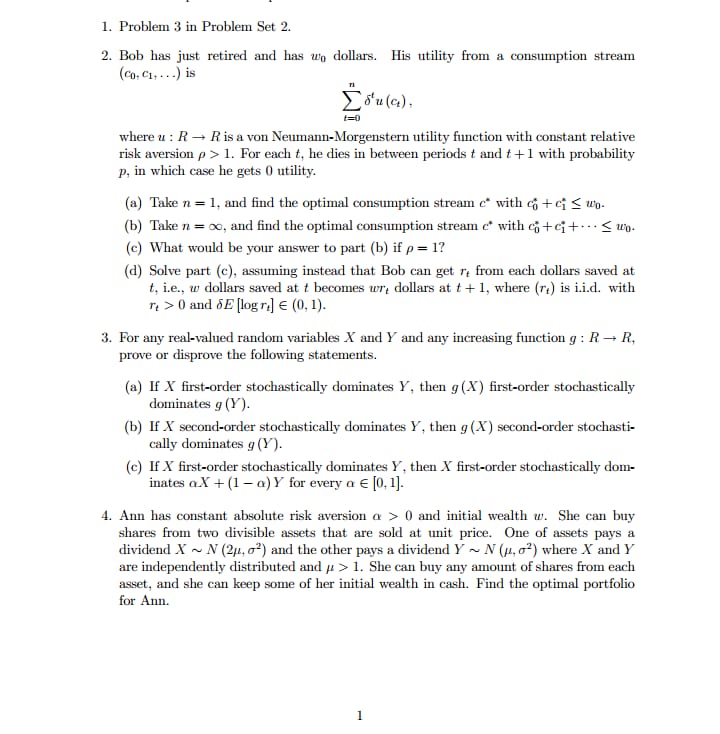
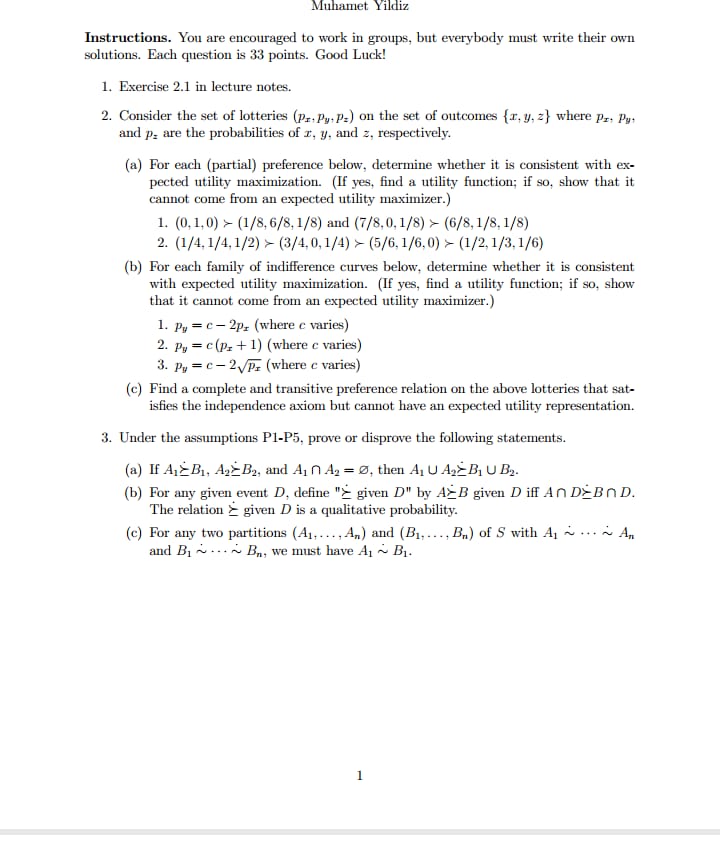
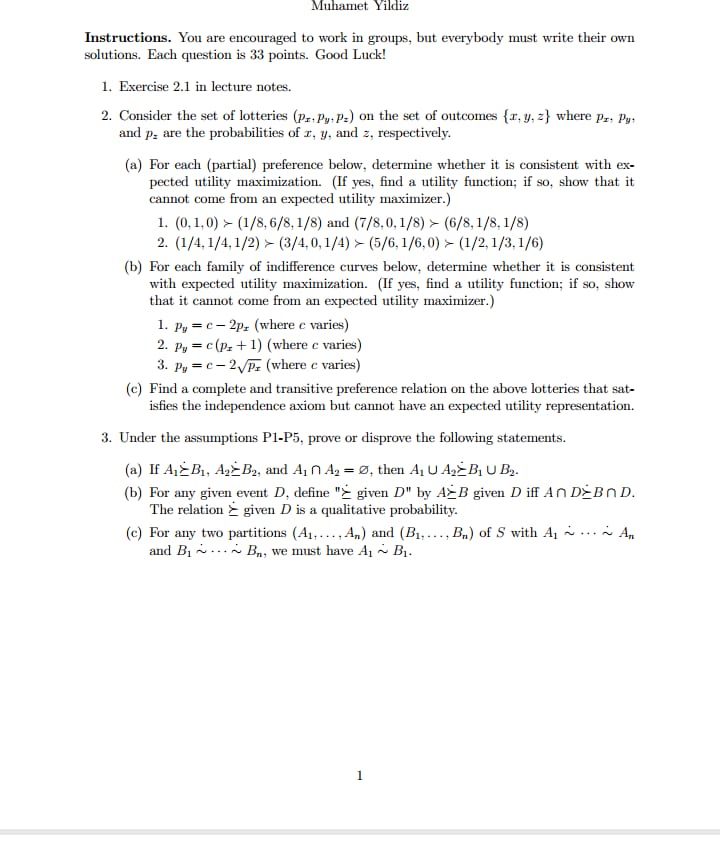
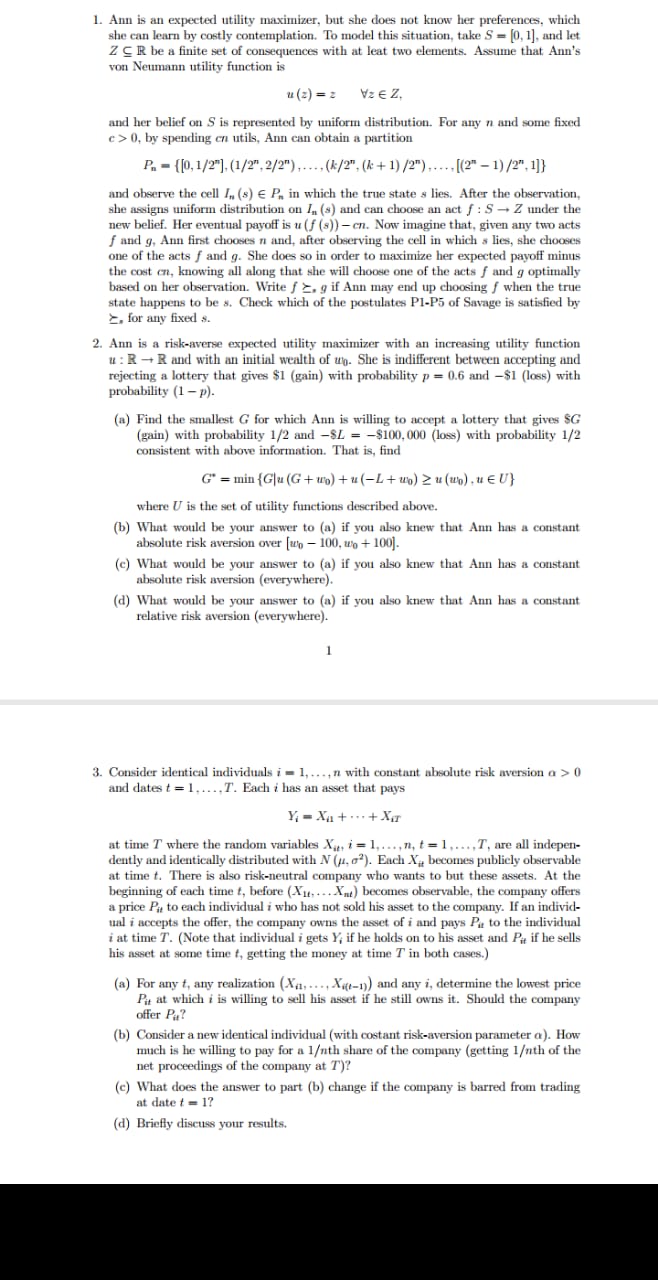

below are my questions..its compl,ete question11
1. Ann is ambiguity-averse and has constant absolute risk aversion a. There is a stock that pays y per unit where y ~ N (u, s') where u e [u, p] is ambiguous. (She maximizes min, E[ul] where u is a CARA utility with a.) Ann can buy or sell any amount of stock. (a) Compute the demand of Ann for the stock as a function of price P of the stock. (b) Suppose there are n copies of Ann and Y total units of stock. Find the market clearing price. (c) Answer the above questions by assuming instead that Ann is an expected utility maximizer with known # c (a. p]- (d) Briefly discuss your answers. 2. There is an asset that pays y where y has a continuous strictly increasing c.d.f. F on some interval [a, b). Ann is a rank-dependent expected utility maximizer with linear utility (i.e. she is "risk-neutral" ) and with probability weighting function w : [0, 1] - [0, 1] where w (x) = e (-loss)" for some a E (0, 1). Let P (a) be the maximum amount Ann is willing to pay the asset. Compute lima- P(a) and lima-1 P(a). 3. Bob has just retired and has wo dollars. His utility from a consumption stream (Co. CI, . . . ) is where u (c)z,) is a reference dependent utility function with v ( y ) = y if y/ 2 0 i dy otherwise for some A 2 1 and r, is the reference point at t. The initial reference point To is 0. (a) Take n = 1, I, = 0 for all t, and find the optimal consumption stream c' with (b) Take n = co, r, = 0 for all t, and find the optimal consumption stream c' with (c) Answer the above questions by taking It = G-1-Lecture 15: Antitrust For some years, Microsoft offered original equipment manufacturers (OEM's) a choice of methods of payment for operating system software. OEM's could either (1) buy the software for each machine on which it was installed at a very high price, or (2) contract on the basis of the numbers of machines sold, regardless of whose operating software was installed (a so-called "per-processor" contract). This practice is not anti-competitive. Lecture 16: Auctions b. In a Dutch (descending price) auction for an object for which the bidders have independent and different valuations, participants should bid their true reservation prices. Lecture 18: Incentives & Information c. Sloan is considering the addition of theft insurance for laptop computers as a part of annual School tuition. All students have laptops, and in the past an average of 5% of these computers has been stolen over the course of a year, at an average loss of $2000 each. On the basis of that experience, the School is thinking of providing the insurance to all students and increasing the tuition by $100. This is a good insurance policy. Among other things, it allows Sloan to break even. Lectures 15 & 18: Common Property & Incentives 4. Consider two farmers and two pieces of land. We want to know what the effect is of each farmer working his own piece of land versus the farmers cooperating and jointly working on the two pieces of land. To simplify the exposition, we will denote these as "independent farmers' and cooperative farmers' respectively. Assume that each farmer (whether independent or cooperative) can decide on his own how much time to spend on farming. Let farmer /'s weekly time spent on farming be denoted /, (in hours per week; so hy for farmer I and hy for farmer 2). The farmer's productivity (expressed in bushels of grain) is directly proportional to the time he spends on farming. In particular, an independent former produces 80 , bushels of grain if he works h, hours per week. Farmers in a cooperative are more productive since they can specialize: a cooperative farmer produces 90 , bushels of grain if he works , hours per week. Cooperative farmers share the output of their farm equally. Let b, be the bushels of grain that farmer i can take home at the end of the year, then by = 80h, for an independent farmer, while by = (90 h, + 90 h,)/2 for a cooperative farmer. Farmers dislike working and more so as they work more. In particular, farmer /'s utility is 11, = b, - 2 We assume that a farmer i will choose h, to maximize his utility up Write out the utility functions of an independent farmer and a cooperative farmer completely in terms of h, and hy. b. How many hours will an independent farmer work (assuming that farmers choose A, to maximize their utility)? What is his utility? How many hours will a cooperative farmer work? What is his utility? d What is the problem with a cooperative farm? What would happen (qualitatively) if 100 farmers worked jointly in a cooperative farm? How could the farmers solve that problem?1. Problem 3 in Problem Set 2. 2. Bob has just retired and has wo dollars. His utility from a consumption stream (Co. CI, . . . ) is So'n(a). where u : R - R is a von Neumann-Morgenstern utility function with constant relative risk aversion p > 1. For each t, he dies in between periods t and t + 1 with probability p, in which case he gets 0 utility. (a) Take n = 1, and find the optimal consumption stream c' with co + ci s up- (b) Take n = co, and find the optimal consumption stream c" with ci t ci t . . . 0 and of [log ri] E (0, 1). 3. For any real-valued random variables X and Y and any increasing function g : R - R. prove or disprove the following statements. (a) If X first-order stochastically dominates Y, then g (X) first-order stochastically dominates g (Y). (b) If X second-order stochastically dominates Y, then g (X) second-order stochastic cally dominates g (Y). (c) If X first-order stochastically dominates Y, then X first-order stochastically dom- inates o.X + (1 - a) Y for every a E [0, 1]. 4. Ann has constant absolute risk aversion a > 0 and initial wealth w. She can buy shares from two divisible assets that are sold at unit price. One of assets pays a dividend X ~ N (2p, o') and the other pays a dividend Y ~ N (p, o?) where X and Y are independently distributed and / > 1. She can buy any amount of shares from each asset, and she can keep some of her initial wealth in cash. Find the optimal portfolio for Ann.Muhamet Yildiz Instructions. You are encouraged to work in groups, but everybody must write their own solutions. Each question is 33 points. Good Luck! 1. Exercise 2.1 in lecture notes. 2. Consider the set of lotteries (Pr: Py p=) on the set of outcomes {r, y, z} where pr: Py: and p, are the probabilities of r, y, and z, respectively. (a) For each (partial) preference below, determine whether it is consistent with ex- pected utility maximization. (If yes, find a utility function; if so, show that it cannot come from an expected utility maximizer.) 1. (0, 1,0) > (1/8, 6/8, 1/8) and (7/8, 0, 1/8) > (6/8, 1/8, 1/8) 2. (1/4, 1/4, 1/2) > (3/4, 0, 1/4) > (5/6, 1/6,0) > (1/2, 1/3, 1/6) (b) For each family of indifference curves below, determine whether it is consistent with expected utility maximization. (If yes, find a utility function; if so, show that it cannot come from an expected utility maximizer.) 1. Py = c- 2pr (where c varies) 2. py = c(pr + 1) (where c varies) 3. py = c-2vps (where c varies) (c) Find a complete and transitive preference relation on the above lotteries that sat- isfies the independence axiom but cannot have an expected utility representation. 3. Under the assumptions P1-P5, prove or disprove the following statements. (a) If And By, Azz By, and Aj n A2 = 0, then A, U A, B, U By. (b) For any given event D, define "_ given D" by A>B given Diff An DEBn D. The relation > given D is a qualitative probability. (c) For any two partitions (A1, ..., An) and (B1, ..., B.) of S with A .. ~ A, and B1~ . . . ~ Bn, we must have A| ~ B1.Muhamet Yildiz Instructions. You are encouraged to work in groups, but everybody must write their own solutions. Each question is 33 points. Good Luck! 1. Exercise 2.1 in lecture notes. 2. Consider the set of lotteries (Pr: Py p=) on the set of outcomes {r, y, z} where pr: Py: and p, are the probabilities of r, y, and z, respectively. (a) For each (partial) preference below, determine whether it is consistent with ex- pected utility maximization. (If yes, find a utility function; if so, show that it cannot come from an expected utility maximizer.) 1. (0, 1,0) > (1/8, 6/8, 1/8) and (7/8, 0, 1/8) > (6/8, 1/8, 1/8) 2. (1/4, 1/4, 1/2) > (3/4, 0, 1/4) > (5/6, 1/6,0) > (1/2, 1/3, 1/6) (b) For each family of indifference curves below, determine whether it is consistent with expected utility maximization. (If yes, find a utility function; if so, show that it cannot come from an expected utility maximizer.) 1. Py = c- 2pr (where c varies) 2. py = c(pr + 1) (where c varies) 3. py = c-2vps (where c varies) (c) Find a complete and transitive preference relation on the above lotteries that sat- isfies the independence axiom but cannot have an expected utility representation. 3. Under the assumptions P1-P5, prove or disprove the following statements. (a) If And By, Azz By, and Aj n A2 = 0, then A, U A, B, U By. (b) For any given event D, define "_ given D" by A>B given Diff An DEBn D. The relation > given D is a qualitative probability. (c) For any two partitions (A1, ..., An) and (B1, ..., B.) of S with A .. ~ A, and B1~ . . . ~ Bn, we must have A| ~ B1.1. Ann is an expected utility maximizer, but she does not know her preferences, which she can learn by costly contemplation. To model this situation, take S = [0, 1], and let Z C R be a finite set of consequences with at leat two elements. Assume that Ann's von Neumann utility function is 1 (2) =2 VIEZ, and her belief on S is represented by uniform distribution. For any n and some fixed c > 0, by spending on utils, Ann can obtain a partition Pa - {[0, 1/2"], (1/2", 2/2") , .... (k/2", (le + 1) /2"). .... [(2" - 1) /2", 1]} and observe the cell I, (s) 6 P. in which the true state s lies. After the observation, she assigns uniform distribution on In (s) and can choose an act f : S - Z under the new belief. Her eventual payoff is u (f (s)) - en. Now imagine that, given any two acts f and g, Ann first chooses n and, after observing the cell in which s lies, she chooses one of the acts f and g. She does so in order to maximize her expected payoff minus the cost on, knowing all along that she will choose one of the acts f and g optimally based on her observation. Write f >. g if Ann may end up choosing f when the true state happens to be s. Check which of the postulates PI-P5 of Savage is satisfied by >. for any fixed s. 2. Ann is a risk-averse expected utility maximizer with an increasing utility function 1 : R -+ R and with an initial wealth of wy. She is indifferent between accepting and rejecting a lottery that gives $1 (gain) with probability p = 0.6 and -$1 (loss) with probability (1 - p)- (a) Find the smallest G for which Ann is willing to accept a lottery that gives $G (gain) with probability 1/2 and -$2 = -$100,000 (loss) with probability 1/2 consistent with above information. That is, find G' = min {Gu (G + to) +u(-L + uo) 2 u(up) . " EU} where U is the set of utility functions described above. (b) What would be your answer to (a) if you also knew that Ann has a constant absolute risk aversion over [up - 100, w% + 100]. (c) What would be your answer to (a) if you also knew that Ann has a constant absolute risk aversion (everywhere). (d) What would be your answer to (a) if you also knew that Ann has a constant relative risk aversion (everywhere). 3. Consider identical individuals i = 1, ...,n with constant absolute risk aversion a > 0 and dates t = 1. .... T. Each i has an asset that pays Yi = Xat..+ Xir at time T where the random variables X,, i = 1, ..., n, t= 1,.... T, are all indepen dently and identically distributed with N (#, o?). Each Xe becomes publicly observable at time t. There is also risk-neutral company who wants to but these assets. At the beginning of each time , before (Xit, ... Net) becomes observable, the company offers a price Pa to each individual i who has not sold his asset to the company. If an individ ual i accepts the offer, the company owns the asset of i and pays Pa to the individual i at time 7. (Note that individual i gets Y, if he holds on to his asset and Pa if he sells his asset at some time f, getting the money at time T in both cases.) (a) For any t, any realization (Xa, ..., Xi(-1)) and any i, determine the lowest price Pit at which i is willing to sell his asset if he still owns it. Should the company offer Pa? (b) Consider a new identical individual (with costant risk-aversion parameter a). How much is he willing to pay for a 1th share of the company (getting 1/ath of the net proceedings of the company at T)? (c) What does the answer to part (b) change if the company is barred from trading at date : = 1? (d) Briefly discuss your results.1. Ann is an expected utility maximizer, but she does not know her preferences, which she can learn by costly contemplation. To model this situation, take S = [0, 1], and let Z C R be a finite set of consequences with at leat two elements. Assume that Ann's von Neumann utility function is 1 (2) =2 VIEZ, and her belief on S is represented by uniform distribution. For any n and some fixed c > 0, by spending on utils, Ann can obtain a partition Pa - {[0, 1/2"], (1/2", 2/2") , .... (k/2", (le + 1) /2"). .... [(2" - 1) /2", 1]} and observe the cell I, (s) 6 P. in which the true state s lies. After the observation, she assigns uniform distribution on In (s) and can choose an act f : S - Z under the new belief. Her eventual payoff is u (f (s)) - en. Now imagine that, given any two acts f and g, Ann first chooses n and, after observing the cell in which s lies, she chooses one of the acts f and g. She does so in order to maximize her expected payoff minus the cost on, knowing all along that she will choose one of the acts f and g optimally based on her observation. Write f >. g if Ann may end up choosing f when the true state happens to be s. Check which of the postulates PI-P5 of Savage is satisfied by >. for any fixed s. 2. Ann is a risk-averse expected utility maximizer with an increasing utility function 1 : R -+ R and with an initial wealth of wy. She is indifferent between accepting and rejecting a lottery that gives $1 (gain) with probability p = 0.6 and -$1 (loss) with probability (1 - p)- (a) Find the smallest G for which Ann is willing to accept a lottery that gives $G (gain) with probability 1/2 and -$2 = -$100,000 (loss) with probability 1/2 consistent with above information. That is, find G' = min {Gu (G + to) +u(-L + uo) 2 u(up) . " EU} where U is the set of utility functions described above. (b) What would be your answer to (a) if you also knew that Ann has a constant absolute risk aversion over [up - 100, w% + 100]. (c) What would be your answer to (a) if you also knew that Ann has a constant absolute risk aversion (everywhere). (d) What would be your answer to (a) if you also knew that Ann has a constant relative risk aversion (everywhere). 3. Consider identical individuals i = 1, ...,n with constant absolute risk aversion a > 0 and dates t = 1. .... T. Each i has an asset that pays Yi = Xat..+ Xir at time T where the random variables X,, i = 1, ..., n, t= 1,.... T, are all indepen dently and identically distributed with N (#, o?). Each Xe becomes publicly observable at time t. There is also risk-neutral company who wants to but these assets. At the beginning of each time , before (Xit, ... Net) becomes observable, the company offers a price Pa to each individual i who has not sold his asset to the company. If an individ ual i accepts the offer, the company owns the asset of i and pays Pa to the individual i at time 7. (Note that individual i gets Y, if he holds on to his asset and Pa if he sells his asset at some time f, getting the money at time T in both cases.) (a) For any t, any realization (Xa, ..., Xi(-1)) and any i, determine the lowest price Pit at which i is willing to sell his asset if he still owns it. Should the company offer Pa? (b) Consider a new identical individual (with costant risk-aversion parameter a). How much is he willing to pay for a 1th share of the company (getting 1/ath of the net proceedings of the company at T)? (c) What does the answer to part (b) change if the company is barred from trading at date : = 1? (d) Briefly discuss your results




















